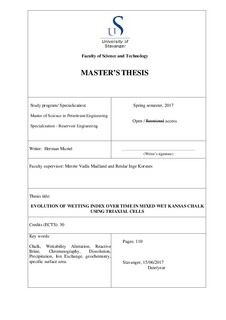| dc.contributor.advisor | Madland, Merete Vadla | |
| dc.contributor.advisor | Korsnes, Reidar Inge | |
| dc.contributor.author | Muriel, Herman | |
| dc.date.accessioned | 2017-11-01T12:45:48Z | |
| dc.date.available | 2017-11-01T12:45:48Z | |
| dc.date.issued | 2017-06 | |
| dc.identifier.uri | http://hdl.handle.net/11250/2463444 | |
| dc.description | Master's thesis in Petroleum engineering | nb_NO |
| dc.description.abstract | Magnesium chloride effects have been widely studied in short and long-term core flooding experiments through outcrop chalk cores. Three main changes are induced by this reactive brine: ion exchange, dissolution of calcite and precipitation of new magnesium bearing minerals. Can these combined mechanisms increase the water wetness of chalk reservoirs?
This experimental work evaluates the potential of simplified brine MgCl2 to modify the initial wetting state of outcrop Kansas chalk cores. Wettability measurements were based on Chromatographic Wettability Test develop by Strand et al. (2006) and carried out at room temperature. The flood of magnesium chloride was performed at Ekofisk reservoir temperature with a flooding rate of 1 PV/day. Wetting state was evaluated every 10 days flooding cycle. Reactive brine flooding was performed using a hydraulic operated triaxial cell with testing conditions of 15 [Bars] confining pressure and 7 [Bars] pore pressure.
The results show that magnesium chloride potential to modify the wetting state of mixed wet Kansas chalk cores is minimum, even though, the chromatographic wettability tests suggest the opposite. Chromatographic wettability test is able to quantify the initial wetting state but not to measure the changes in evolution of the wetting state by flooding a reactive brine through the calcite surface. Insight of aging and sulphate content are presented for outcrop Kansas chalk. The observed effluent concentration suggests a reduction in Mg2+, while the Ca2+ concentration is increased. This, together with density measurements, indicate the precipitation of magnesium bearing minerals causing the dissolution of calcite surface, observing a general increase in the core density to a more magnesite state. Density was found to be higher in the core’s inlet. Furthermore, specific surface area measurements were carried out. An apparent link between specific surface area and the chromatographic wettability test area measured was implied. Magnesium chloride could potentially increase the specific surface area of the core, while sodium chloride could reduce it (Unpublished work by Wang et al. (2017). Same trends were found in the chromatographic separation test results. | nb_NO |
| dc.language.iso | eng | nb_NO |
| dc.publisher | University of Stavanger, Norway | nb_NO |
| dc.relation.ispartofseries | Masteroppgave/UIS-TN-IPT/2017; | |
| dc.subject | petroleumsteknologi | nb_NO |
| dc.subject | petroleum engineering | nb_NO |
| dc.subject | chalk | nb_NO |
| dc.subject | wettability alteration | nb_NO |
| dc.subject | reactive brine | nb_NO |
| dc.subject | chromatography | nb_NO |
| dc.subject | dissolution | nb_NO |
| dc.subject | precipitation | nb_NO |
| dc.subject | ion exchange | nb_NO |
| dc.subject | geochemistry | nb_NO |
| dc.subject | specific surface area | nb_NO |
| dc.title | Evolution of wetting index over time in mixed wet Kansas chalk using triaxial cells | nb_NO |
| dc.type | Master thesis | nb_NO |
